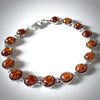Russian Icons: A History.
- Victoria Rybalov

Russian Icons
The use and making of Russian Icons entered Kievan Rus (Киевская Русь) following its conversion to Orthodoxy in 988 AD. As an adaptive rule, these icons strictly followed models and formulas hallowed from the capital in Constantinople. As time passed, the Russians expanded the styles and artwork far beyond anything found elsewhere in the Orthodox world.
The personal, innovative, and creative traditions of Western European religious art, were largely lacking in Russia before the 17th century. It was around this time that Russian icon painting began becoming strongly influenced by religious paintings and engravings from both Protestant and Catholic Europe. Reforms between 1652 and 1666 in liturgy and practice instituted by Patriarch Nikon of Moscow (Никон) with the support of the Moscovite state power resulted in a split in the Russian Orthodox Church. The traditionalists (persecuted "Old Ritualists" or "Old believers -- староверы) continued the traditional stylization of icons, while the State Church modified its practice. From that time icons began to be painted not only in the traditional stylized and non-realistic mode, but also in a mixture of Russian stylization and Western European realism, and in a Western European manner very much like that of Catholic religious art of the time. These types of icons, while found in Russian Orthodox churches, are also sometimes found in various catholic churches and cathedrals.
Russian icons are typically painted on small pieces of wood and sometimes decorated with copper or gold though some in churches and monasteries may be larger. Many religious homes in Russia have icons hanging on the wall in the Krasny Ugol, meaning "beautiful" corner. Sometimes an icon is made as a triptych from Greek "triptukhon" which includes three different images. During travel, the panels are folded together for protection.
There is a rich history and elaborate religious symbolism associated with icons. In Russian churches, the nave is typically separated from the sanctuary by an iconostasis ( иконостас), or icon-screen, a wall of icons with double doors in the center.
Russians sometimes speak of an icon as having been "written", because in the Russian language like in Greek, but unlike in English the same word "pisat' писать in Russian means both to paint and to write. Icons are considered to be the Gospel in paint, and therefore careful attention is paid to ensure that the Gospel is faithfully and accurately conveyed to followers.
Icons are considered miraculous were they appear.
The "appearance" yavlenie, явление of an icon is a supposedly miraculous discovery. "A true icon is one that has 'appeared', a gift from above
At www,buyrussiangifts.com we have a great collection of icons. They are proudly produced in Ukrainian churches and are blessed.









Thank you for the interesting information.